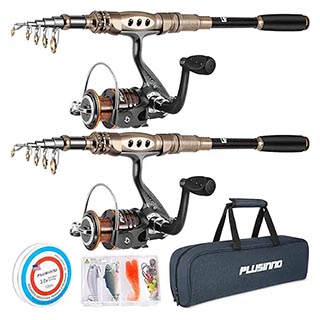Not Just Fishing
Fishing Articles and Information

Pike - Learn the facts that so you catch the trophies
By Robert W Benjamin
This voracious and carnivorous fish live in freshwaters on the Northern Hemisphere.
Northern Pike (Esox lucius) is also known
by its folk name of "Water Wolf".
Pikes grow as large as 150 cm in size and 25 kg in weight (1' to over 4', and weigh 50 pounds),
although larger sizes have been reported, particularly in the Great Lakes area, making people believe in a misidentification
or folk tale.
The color of Northern Pikes is olive shading into whitish or yellowish on belly, with spots on their body and some dark ones
on the fins.
Pikes have large pores on their head and lower jaw.
This characteristic make Northern Pike a close relative to
Muskellunge, similar-looking, but Northern Pike have light markings on their dark body backgrounds and less than 6 sensory
pores on the underside of their jaw.
Usually found in cold, clear, rocky waters, lakes and streams, Northern Pike are usually hidden waiting for their prey, which
are caught sideways with their sharp teeth.
Pikes eat mainly fish and ducklings, although they are also cannibals, part of
their nature, which serves in maintaining the Northern Pike population.
Some anglers have photographed Northern Pikes eating other pikes of a similar size, but also leeches and insects, because they are well known for their tremendously voracious appetite.
Northern Pikes are some of the biggest freshwater fish that anglers
like to catch due to the challenge involved while facing their aerial acrobatics and explosive hits.
Fishing for pike is an exciting sport in North America, where anglers usually do not eat the catch, but northern pike is usually filleted for the purpose of European cuisine, particularly popular in many German dishes.
There are references traced back as far as the Romans, depicting pikes served at festivities.
In America, Northern Pike lives in northern New England, Eastern New York, Minnesota and the Ohio Valley, the Great Lakes basin and also the surrounding states of Nebraska and Missouri.
Toward the north, pikes are also found in Alaska and Canada, except, British Columbia, were they appear rarely.
Northern Pike breed with Muskie to produce the Muskellunge subspecies known as Tiger Muskellunge (Esox masquinongy immaculatus) and there is also a mutation of Northern pike known as the Silver Pike, silvery-blue or silver in color, often referred to as
Silver Muskellunge, occurring in scattered populations, lacking the rows of spots.
The name of Northern Pike was given to this specie after its North American habitat resembling the pole-weapon known as pike. This fish is also known as Common Pike, Snake, Great Northern Pike, American Pike, Jackfish, Great Lakes Pike, Grass Pike, and
Pickerel.
There is a website that has great information on most species of freshwater fish. It has details that pertain to each species
of fish such as habitat, spawning, eating habits, the best lures and baits and more, the website is called: Fishing Stringer,
and can be found at this url:
http://www.fishingstringer.com
By Robert W. Benjamin Copyright © 2007
About the Author
Robert W. Benjamin has been in the software business on the internet for over 5 years, and has
been producing low-cost softwarefor the past 25+ years. He first released products on the AMIGA and C64 computer systems in the late 1970's-80's.
Seasonal Vacation Spots
http://www.seasonalvacationspots.com







